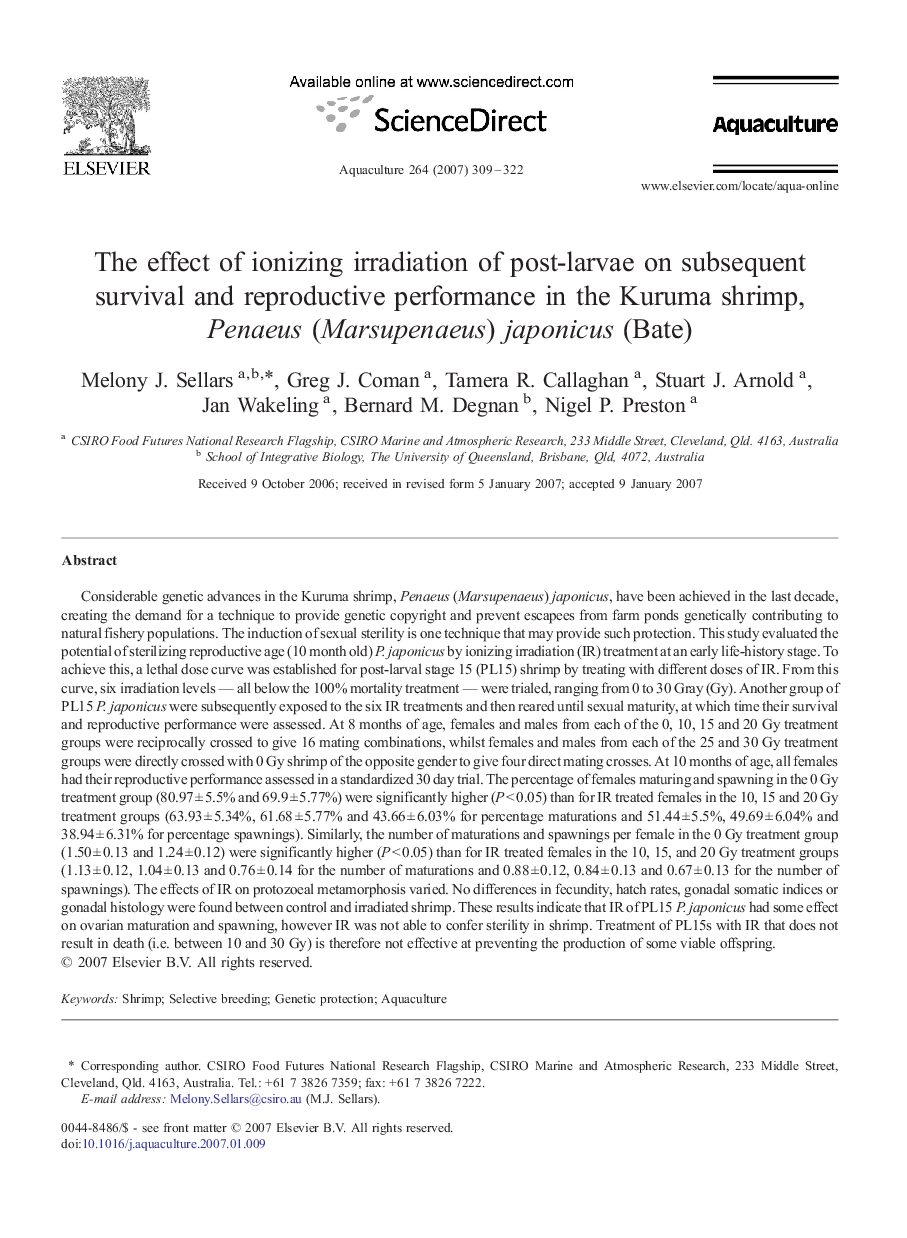| Article ID | Journal | Published Year | Pages | File Type |
|---|---|---|---|---|
| 2425388 | Aquaculture | 2007 | 14 Pages |
Abstract
Considerable genetic advances in the Kuruma shrimp, Penaeus (Marsupenaeus) japonicus, have been achieved in the last decade, creating the demand for a technique to provide genetic copyright and prevent escapees from farm ponds genetically contributing to natural fishery populations. The induction of sexual sterility is one technique that may provide such protection. This study evaluated the potential of sterilizing reproductive age (10 month old) P. japonicus by ionizing irradiation (IR) treatment at an early life-history stage. To achieve this, a lethal dose curve was established for post-larval stage 15 (PL15) shrimp by treating with different doses of IR. From this curve, six irradiation levels - all below the 100% mortality treatment - were trialed, ranging from 0 to 30 Gray (Gy). Another group of PL15 P. japonicus were subsequently exposed to the six IR treatments and then reared until sexual maturity, at which time their survival and reproductive performance were assessed. At 8 months of age, females and males from each of the 0, 10, 15 and 20 Gy treatment groups were reciprocally crossed to give 16 mating combinations, whilst females and males from each of the 25 and 30 Gy treatment groups were directly crossed with 0 Gy shrimp of the opposite gender to give four direct mating crosses. At 10 months of age, all females had their reproductive performance assessed in a standardized 30 day trial. The percentage of females maturing and spawning in the 0 Gy treatment group (80.97 ± 5.5% and 69.9 ± 5.77%) were significantly higher (P < 0.05) than for IR treated females in the 10, 15 and 20 Gy treatment groups (63.93 ± 5.34%, 61.68 ± 5.77% and 43.66 ± 6.03% for percentage maturations and 51.44 ± 5.5%, 49.69 ± 6.04% and 38.94 ± 6.31% for percentage spawnings). Similarly, the number of maturations and spawnings per female in the 0 Gy treatment group (1.50 ± 0.13 and 1.24 ± 0.12) were significantly higher (P < 0.05) than for IR treated females in the 10, 15, and 20 Gy treatment groups (1.13 ± 0.12, 1.04 ± 0.13 and 0.76 ± 0.14 for the number of maturations and 0.88 ± 0.12, 0.84 ± 0.13 and 0.67 ± 0.13 for the number of spawnings). The effects of IR on protozoeal metamorphosis varied. No differences in fecundity, hatch rates, gonadal somatic indices or gonadal histology were found between control and irradiated shrimp. These results indicate that IR of PL15 P. japonicus had some effect on ovarian maturation and spawning, however IR was not able to confer sterility in shrimp. Treatment of PL15s with IR that does not result in death (i.e. between 10 and 30 Gy) is therefore not effective at preventing the production of some viable offspring.
Related Topics
Life Sciences
Agricultural and Biological Sciences
Aquatic Science
Authors
Melony J. Sellars, Greg J. Coman, Tamera R. Callaghan, Stuart J. Arnold, Jan Wakeling, Bernard M. Degnan, Nigel P. Preston,
